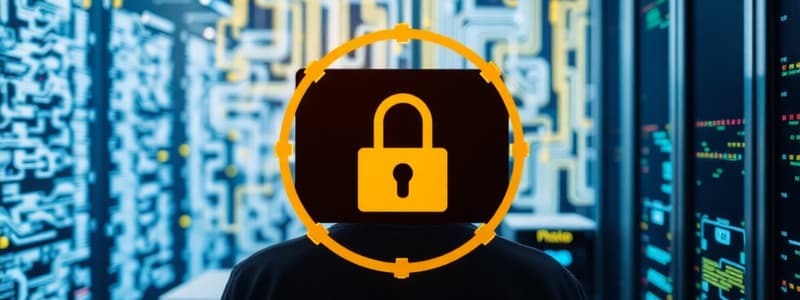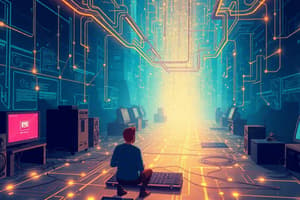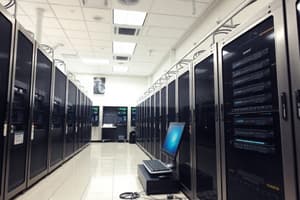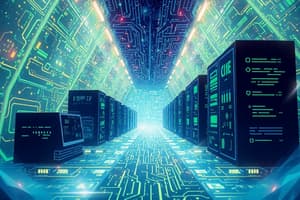Podcast
Questions and Answers
Information technology is responsible for such a large portion of our ______, business operations and personal access to information.
Information technology is responsible for such a large portion of our ______, business operations and personal access to information.
workforce
The word computer is derived from the Latin word '______', which means to calculate.
The word computer is derived from the Latin word '______', which means to calculate.
computare
[Blank] is a collection of unorganized facts & figures and does not provide any further information regarding patterns, context, etc.
[Blank] is a collection of unorganized facts & figures and does not provide any further information regarding patterns, context, etc.
Data
[Blank] is the function that refers to how information gets into the computer.
[Blank] is the function that refers to how information gets into the computer.
The ______ takes information from input devices and memory storage and processes it according to programmed instructions.
The ______ takes information from input devices and memory storage and processes it according to programmed instructions.
Processed information gets sent to ______ so users can interact with it.
Processed information gets sent to ______ so users can interact with it.
[Blank] components are used to store data temporarily and the data stored will be erased when the system is shut down.
[Blank] components are used to store data temporarily and the data stored will be erased when the system is shut down.
Components are used to store data permanently; data stored is not erased when the system is shutdown. [Blank] is the most common component of this.
Components are used to store data permanently; data stored is not erased when the system is shutdown. [Blank] is the most common component of this.
Executing mathematical calculation, a computer works faster and more ______ than a human.
Executing mathematical calculation, a computer works faster and more ______ than a human.
[Blank] refers to a capacity of a computer, performance of different types of tasks with the same accuracy and efficiency.
[Blank] refers to a capacity of a computer, performance of different types of tasks with the same accuracy and efficiency.
Computer memory storage capacity is measured in Bytes, Kilobytes(KB), Megabytes(MB), Gigabytes(GB), and ______.
Computer memory storage capacity is measured in Bytes, Kilobytes(KB), Megabytes(MB), Gigabytes(GB), and ______.
The world is quickly moving toward ______ (Artificial Intelligence)-based technology.
The world is quickly moving toward ______ (Artificial Intelligence)-based technology.
The four phases of computing process are the input, processing, ______, and storage.
The four phases of computing process are the input, processing, ______, and storage.
The ______ is the brain of the computer and it is the one that helps the computer to process the data from input.
The ______ is the brain of the computer and it is the one that helps the computer to process the data from input.
[Blank] is used for temporary storage that keeps the data while the computer is running or open.
[Blank] is used for temporary storage that keeps the data while the computer is running or open.
[Blank] are all of the physical aspects of a computer system, tangible, i.e. you can see and touch them.
[Blank] are all of the physical aspects of a computer system, tangible, i.e. you can see and touch them.
[Blank] is nothing but a set of programmes (computer instructions), which helps the user to do a set of specific tasks.
[Blank] is nothing but a set of programmes (computer instructions), which helps the user to do a set of specific tasks.
[Blank] are a set of instructions, written in code, to instruct a computer on how to perform a task, run a software, do calculations etc.
[Blank] are a set of instructions, written in code, to instruct a computer on how to perform a task, run a software, do calculations etc.
For users to input data into the computer system using ______.
For users to input data into the computer system using ______.
An example of ______ is monitors, screens and printers.
An example of ______ is monitors, screens and printers.
The First generation of computers used ______ for circuitry and magnetic drums for memory.
The First generation of computers used ______ for circuitry and magnetic drums for memory.
In second-generation computers, COBOL and FORTRAN are employed as ______languages.
In second-generation computers, COBOL and FORTRAN are employed as ______languages.
The Third-generation computers used ______, popularly known as Chips.
The Third-generation computers used ______, popularly known as Chips.
The fourth-generation computers uses Large Scale Integrated Circuits (LSIC) built on a single silicon chip called ______.
The fourth-generation computers uses Large Scale Integrated Circuits (LSIC) built on a single silicon chip called ______.
Fifth-generation computers use ______ (Ultra Large Scale Integration) technology.
Fifth-generation computers use ______ (Ultra Large Scale Integration) technology.
A ______ is a traditional method of data storage that uses tangible documents such as paper records, files, or folders.
A ______ is a traditional method of data storage that uses tangible documents such as paper records, files, or folders.
With computers and the internet, ______ is no longer confined to classrooms.
With computers and the internet, ______ is no longer confined to classrooms.
Analyzing large datasets to find new treatments and understand diseases better is called ______.
Analyzing large datasets to find new treatments and understand diseases better is called ______.
Computers are used to power advanced ______ in sports.
Computers are used to power advanced ______ in sports.
CAD software helps design theaters, optimizing space and ______.
CAD software helps design theaters, optimizing space and ______.
[Blank] surveillance involves monitoring people with technology, often without their knowledge.
[Blank] surveillance involves monitoring people with technology, often without their knowledge.
[Blank] is the stealing of another person's social security number, credit card number, or other personal information for the purpose of borrowing money, making purchases, and running up debts.
[Blank] is the stealing of another person's social security number, credit card number, or other personal information for the purpose of borrowing money, making purchases, and running up debts.
[Blank] is a type of malware that encrypts a victim's data until a ransom is paid.
[Blank] is a type of malware that encrypts a victim's data until a ransom is paid.
[Blank] is the physical components that make up a computer system.
[Blank] is the physical components that make up a computer system.
The ______ is the main circuit board of a computer, containing components such as the CPU, RAM, and ROM chips.
The ______ is the main circuit board of a computer, containing components such as the CPU, RAM, and ROM chips.
The ______ is the 'brain' of the computer which has two parts: the Arithmetic Logic Unit (ALU) and the Control Unit.
The ______ is the 'brain' of the computer which has two parts: the Arithmetic Logic Unit (ALU) and the Control Unit.
[Blank] temporarily stores frequently used instructions and data, speeding up processing.
[Blank] temporarily stores frequently used instructions and data, speeding up processing.
[Blank] refers to devices that permanently hold dataand information, such as programs.
[Blank] refers to devices that permanently hold dataand information, such as programs.
[Blank] devices translatedata into a formthat computers can understand.
[Blank] devices translatedata into a formthat computers can understand.
The ______ is a fundamental framework for computer networking that stands for Transmission Control Protocol/Internet Protocol.
The ______ is a fundamental framework for computer networking that stands for Transmission Control Protocol/Internet Protocol.
An ______ is a Unique identifier that is contained by all the resources available on the internet.
An ______ is a Unique identifier that is contained by all the resources available on the internet.
The Third-generation computers used ______ (ICs), also known as chips, which drastically increased the speed and efficiency of computers by placing transistors on silicon chips.
The Third-generation computers used ______ (ICs), also known as chips, which drastically increased the speed and efficiency of computers by placing transistors on silicon chips.
A ______ is a versatile tool in problem-solving, especially useful when facing a multifaceted issue, promoting collaboration by helping breakdown the complexity into digestible parts that can be useful for a variety of scenarios.
A ______ is a versatile tool in problem-solving, especially useful when facing a multifaceted issue, promoting collaboration by helping breakdown the complexity into digestible parts that can be useful for a variety of scenarios.
In the context of computer storage, ______ components are used for long-term data retention, with data remaining intact even after the system is powered off, unlike their temporary counterparts.
In the context of computer storage, ______ components are used for long-term data retention, with data remaining intact even after the system is powered off, unlike their temporary counterparts.
In computer architecture, special high-speed storage locations within the CPU used to hold instructions, memory addresses, or data while it is being processed by the CPU during the execution of instructions are called ______.
In computer architecture, special high-speed storage locations within the CPU used to hold instructions, memory addresses, or data while it is being processed by the CPU during the execution of instructions are called ______.
Within the Software Development Life Cycle various models can be utilized, the ______ model is risk-driven. Used for the best features from the waterfall, prototyping models, and introduces a new component; risk assessment
Within the Software Development Life Cycle various models can be utilized, the ______ model is risk-driven. Used for the best features from the waterfall, prototyping models, and introduces a new component; risk assessment
Flashcards
Information Technology (IT)
Information Technology (IT)
Use of computer systems/devices to access information.
Computer
Computer
Programmable electronic device for retrieving, storing, and processing data.
Data
Data
Unorganized facts & figures that provide no context.
Information
Information
Signup and view all the flashcards
Input Function
Input Function
Signup and view all the flashcards
Processing
Processing
Signup and view all the flashcards
Output Function
Output Function
Signup and view all the flashcards
Storage Function
Storage Function
Signup and view all the flashcards
Temporary Storage
Temporary Storage
Signup and view all the flashcards
Permanent Storage
Permanent Storage
Signup and view all the flashcards
Speed (Characteristic)
Speed (Characteristic)
Signup and view all the flashcards
Diligence (Characteristic)
Diligence (Characteristic)
Signup and view all the flashcards
Accuracy (Characteristic)
Accuracy (Characteristic)
Signup and view all the flashcards
Reliability (Characteristic)
Reliability (Characteristic)
Signup and view all the flashcards
Versatility (Characteristic)
Versatility (Characteristic)
Signup and view all the flashcards
Memory (Characteristic)
Memory (Characteristic)
Signup and view all the flashcards
Automation (Characteristic)
Automation (Characteristic)
Signup and view all the flashcards
Data Processing
Data Processing
Signup and view all the flashcards
Computing Phases
Computing Phases
Signup and view all the flashcards
Input (Computing Phase)
Input (Computing Phase)
Signup and view all the flashcards
Processing (Computing Phase)
Processing (Computing Phase)
Signup and view all the flashcards
Output (Computing Phase)
Output (Computing Phase)
Signup and view all the flashcards
Storage (Computing Phase)
Storage (Computing Phase)
Signup and view all the flashcards
RAM
RAM
Signup and view all the flashcards
Hard Drives
Hard Drives
Signup and view all the flashcards
Hardware
Hardware
Signup and view all the flashcards
Input Hardware
Input Hardware
Signup and view all the flashcards
Output Hardware
Output Hardware
Signup and view all the flashcards
Processing and memory hardware
Processing and memory hardware
Signup and view all the flashcards
Secondary Storage Hardware
Secondary Storage Hardware
Signup and view all the flashcards
Software
Software
Signup and view all the flashcards
People
People
Signup and view all the flashcards
Procedures
Procedures
Signup and view all the flashcards
Data
Data
Signup and view all the flashcards
Connectivity
Connectivity
Signup and view all the flashcards
First Generation Computer
First Generation Computer
Signup and view all the flashcards
Second Generation Computer
Second Generation Computer
Signup and view all the flashcards
Third Generation Computer
Third Generation Computer
Signup and view all the flashcards
Fourth Generation Computer
Fourth Generation Computer
Signup and view all the flashcards
Fifth Generation Computer
Fifth Generation Computer
Signup and view all the flashcards
Computer Based Database
Computer Based Database
Signup and view all the flashcards
Paper Based Database
Paper Based Database
Signup and view all the flashcards
Use of computer in business communication
Use of computer in business communication
Signup and view all the flashcards
Computer in education
Computer in education
Signup and view all the flashcards
Computers in Medical Field
Computers in Medical Field
Signup and view all the flashcards
Study Notes
Introduction to Information Technology
- Information Technology (IT) utilizes computer systems/devices to access information.
- IT is vital in global workforce, business operations, and personal information access.
What is a Computer?
- "Computer" derives from the Latin "computare", meaning to calculate.
- A computer is a programmable electronic device that can retrieve, store, and process data.
- It comprises hardware (processor, memory, etc.) and software (applications, operating systems, etc.).
Data vs. Information
- Data: Unorganized facts and figures lacking context or pattern; unstructured.
- Information: Organized, meaningful, and processed data.
- Computers process raw data and convert it to structured information.
Functions of a Computer System
- Input: Receiving information through input devices (keyboard, mouse, etc.).
- Processing: The CPU processes information from input and memory using programmed instructions.
- Output: Displaying processed information through output devices (monitors, speakers, etc.).
- Storage: Storing information for later use, either temporarily or permanently.
Temporary vs. Permanent Storage
- Temporary Storage: Data is erased when the system shuts down; RAM is a primary example.
- Permanent Storage: Data remains even after shutdown; hard disks, USB drives, and CDs/DVDs serve as permanent storage.
Characteristics of Computers
- Speed: Executes calculations faster/more accurately than humans.
- Diligence: Operates for hours without tiring
- Accuracy: Low chance of errors during computations.
- Reliability: Stable output, unless the input data is inconsistent.
- Versatility: Handles different tasks with similar accuracy and efficiency.
- Memory: Stores millions of precisely accessible records. Storage capacity is measured in Bytes, KB, MB, GB, and TB.
- Automation: Performs programmed tasks automatically, enabled by Artificial Intelligence (AI).
How Computers Process Data
- Transforms raw input into meaningful information.
- Utilizes four key phases: Input, Processing, Output, and Storage.
Four Phases of Computing Process
- Phase 1: Input involves entering data using keyboards, mice, cameras, or touchscreens.
- Phase 2: Processing occurs as the CPU, the computer's "brain," handles input data.
- Phase 3: Output presents final processed information via screens, videos, audio devices, or printers.
- Phase 4: Storage preserves data on the computer or portable devices for future use via RAM or Hard Drives.
Elements of a Computer System
- Hardware: Physical components like keyboards, monitors, and printers.
- Software: Programs/instructions that enable users to perform tasks.
- People: Users interacting with the computer system.
- Procedures: Instructions in code that guide the computer.
- Data: Raw facts and figures inputted into the computer.
- Connectivity: Linking computers to networks for sharing information via LAN, Wi-Fi, etc.
Computing Definition
- Computing involves a device accepting data/ input and processing to produce a resultant output.
First Generation Computers (1940-1956): Vacuum Tubes
- Utilized vacuum tubes for circuitry and magnetic drums for memory.
- Were large, slow, consumed high electricity, and used machine language.
- Solved problems one at a time with input via punched cards/paper tapes, output via printouts. Limitations encompassed slow operating speed, high power consumption, the need of large installation spaces, and low programming capability.
Second Generation Computers (1957-1963): Transistors
- Employs COBOL and FORTRAN for assembly/programming languages.
- Transistors replaced vacuum tubes which were smaller, faster, and more energy-efficient.
- Advanced from binary to assembly languages using IBM 1620, IBM 7094, CDC 1604, CDC 3600.
- Instructions were stored in their memory, and the concept of CPU and input/output units was developed.
- Transistors replaced bulky electric tubes in the first-generation computers since they were smaller, had higher operating speeds, needed no heating, and had a low manufacturing cost.
Third Generation Computers (1964-1971): Integrated Circuits
- Introduced in 1964, used Integrated Circuits (ICs), also known as chips.
- Transistors were miniaturized and placed on silicon chips (semiconductors).
- Interacted via keyboards/monitors with an operating system to allow different applications with central memory management.
- They became smaller, cheaper, and accessible to a mass audience.
Fourth Generation Computers(1970s-Present) : Microprocessors
- Started around 1975, with Large Scale Integrated Circuits (LSIC) on single silicon chips (microprocessors).
- Enabled placing computers' CPU on a single chip (microcomputers).
- Led to smaller, more powerful computers, linked to form networks, and the birth of the Internet. Graphical User Interfaces (GUIs), mice, and handheld devices were developed.
Fifth Generation (1980–Present): Artificial Intelligence
- Utilized since 1980 and are currently used.
- Defines Artificial intelligence.
- Uses parallel processing and superconductors.
- Employs ULSI technology.
- Uses programming languages like C, C++, Java, .NET; examples include IBM, Pentium, Desktop, Laptop, Notebook, and Ultrabook computers.
Computer-Based vs. Paper-Based Databases
- Computer-based: Data collection stored, organized, and managed using computer software.
- Paper-based: Data storage traditional method using tangible documents including paper records and files.
Computers in Business and Industries
- Computers are integral as business tool.
- They are utilized for product creation, marketing, accounting, and administration.
- Communications: Improves business communications.
- Research: Enables quick access to vast information and complex analysis.
- Sales and Marketing: Aids CRM, sales tracking, and marketing.
- Data Management & Storage: Allows secure storage and efficient data handling.
- Product Development: Enhances every stage of product development.
Computers in Education
- Use computer systems and technology to facilitate teaching and learning.
- Used for access, data management, and sharing.
- Encourages interaction, efficiency, and personalized learning. access to online information, interactive learning, distant learning, student assessment and skill development.
- Promote collaborative learning, give personalized learning , Increase student engagement with tools, and promote learning to remote learners. Challenges for education included limited access, distractions, and costs.
Computers in Medicine
- Essential for healthcare innovation, accessibility, and effectiveness.
- Aid in medical imaging (X-rays, CT scans), robotic surgery, and telemedicine (remote consultations).
- Make easy access to patient info, manage hospital ,and tailor treatment to patients.
- They also help study using Data analysis large groups and improve training.
Computers in Art and Design
- Graphic Design: Enable creation and editing of visual content.
- Digital Art: Facilitate painting and sculpture.
- Video Editing: Assist in post-production and effects.
Computers in Entertainment, Sports, and Leisure
- Entertainment: Used for streaming, gaming, animation, and editing.
- Music: Revolutionize the economics of music.
- Sports: Help analyze data for data such as physical fitness tests.
- Sports: Are utilized to power scoreboards and simulations for viewing.
- Leisure: Enable social media connections.
Computers in Theater, Lighting, Music and Dance
- In design the theater utilizing CAD software.
- Stage lighting is synced with performances.
- Music creation: help create musical pieces.
- Dance : Capture motion create choreography
Flaws and Flaws on Efficiency
- Hardware issues such as crashes, Bugs cause issues, Cyber security increases risk.
- Over reliance requires constant updates.
Ethical Problems
- Electronic surveillance affects privacy.
- Identity theft is the stealing of social security, credit card etc.
- Cookies track for information.
malware
- Spyware can still data, and Trojan horses spread through downloads.
- Viruses, Direct action , polymorphic code all attack computer code.
- Ransom ware steals until payed the user needs to defend themselves.
Computer Hardware.
- This is the hardware, the physical part of the computer.
- That the system unite needs secondary storage, input out put and communication.
- It also contains the motherboard and CPU
- And stores using RAM and ROM.
- Ports and expansion slot.
Secondary Storage
- Permanently stored data and programms.
- can also use floppy disc,hard drives.
- magnetic discs, opticak disc etc
I/O Devices
- Are translated into understandable commands for the devices , as well as humnas.
Communication Devices
- They allow sending via modem and cards to networks
- There has been and evolution through First, Second, Third, Fours and fifth evolution
- Devices can be classified as input, processing oputput etc
- You also need CPU that executes instructions on the motherboard.
Memory Devices
- Random access such as Ram and HHDs.
Different Types of computers.
- Here are descriptions of main components.
Data, Algorithms and flowcharts.
What is a Program
- Is the piece of code with set of instructions to execute
- There are 6 steps : analyze, design the program, code it ,debugg it,fromalise the program and maintain the flow.
What is Algorithm
- Algorithm set of directions in way to get expected resuilts.
- Finiteness, definite, effectivesness and at least one outpit.
What is Flowchart
- In the most simple , A visual algorithm with graphical
- Flowchart uses symbols.
- Help resolve specific problems
- Come in many shapes, and they facilitate solving the issue on hand
Components
- Flowchart help break decision into smaller tasks.
- This visual are great for new users.
Classifications of flowcharts
- Process chart is visual .Swimlane flow chart is for team.
- There are also descriptions , flowcharts ,work flow and data.
What is a Register
- Small memory to change instructions.
- Data resisters, data,instruction,memory
- There can be problems with shifting numbers, storage and shift loading. Solution use registers and Rom and Ram
Also described is the function of CPU , devices Also describe devices and flow for analysis
Internet and protocols
- Essential tool connecting many million of devices .
- Requires TCP/Ip
- Requires Url for address.
- Use key phrases for engines like google for research.
- FPT protocols, cloud. Storing files streaming services are used.
- Easy, compatible access is used on all kinds of systems
- Make sure to use antivirus and safety measures.
Studying That Suits You
Use AI to generate personalized quizzes and flashcards to suit your learning preferences.




